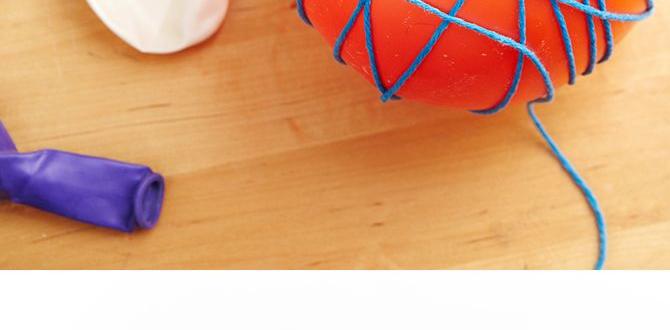Don’t let heavy tools weigh down your furniture-building dreams. A lightweight nailer is your secret weapon for precision, comfort, and speed. This guide helps beginners find the perfect lightweight nailer for beautiful, stress-free furniture projects.
Table of Contents
Lightweight Nailer for Furniture Building: Your Essential Guide
Building furniture can be incredibly rewarding, but sometimes the tools can feel, well, daunting. If you’ve ever wrestled with an awkward, heavy nail gun, you know it can zap your energy and actually make your projects harder. The good news is that there’s a perfect solution for home builders and DIYers: a lightweight nailer. These amazing tools make attaching pieces feel like a breeze, helping you create beautiful furniture without the strain. We’ll walk you through everything you need to know to pick the right one and get building!
Imagine effortlessly stepping through your furniture projects, your hands steady, your back comfortable. That’s the power of a lightweight nailer. No more fatigue slowing you down or causing little mistakes. We’re here to guide you, step-by-step, to finding this game-changer for your workshop.
Why a Lightweight Nailer is a Furniture Builder’s Best Friend
When it comes to furniture building, especially for those of us who aren’t professional cabinet makers (yet!), precision and comfort are king. Traditional nailers can be bulky and heavy, which means:
- Fatigue Sets In Faster: Holding a heavy tool for extended periods can lead to arm, shoulder, and back strain. This makes working on larger projects tiring.
- Reduced Control: When you’re tired, it’s harder to hold the nailer steady. This can result in crooked nails or missed placements, leading to frustrating workarounds.
- Slower Progress: Constantly repositioning a heavy tool and taking breaks due to discomfort slows down your building process.
- Potential for Injury: Overexertion from heavy tools can increase the risk of muscle strains or other minor injuries.
A lightweight nailer, however, flips this script. It’s designed to feel like an extension of your arm, not a burden. This allows for:
- Extended Work Comfort: Work for longer periods without feeling worn out.
- Improved Accuracy: Better control means more precise nail placement.
- Faster Assembly: Keep your workflow smooth and efficient.
- Safer Operation: Less strain means better focus and handling.
For furniture projects that often involve many repetitive nailing tasks, like assembling cabinet boxes, attaching trim, or building drawers, a lightweight nailer truly shines. It makes the difference between a project you conquer and one that defeats you.
Understanding Nailer Types for Furniture Building
Before we dive into weight, let’s quickly cover the main types of nailers you’ll encounter. Each has its strengths, and understanding them helps you choose the best fit for your furniture needs.
1. Brad Nailers
These are perfect for delicate trim work, smaller moldings, and any furniture joints where you need a clean, minimal hole. Brad nails are thin and have small heads, leaving behind tiny, easily filled marks.
- Size: Typically use 18-gauge nails (hence often called “18-gauge nailers”).
- Best for: Attaching delicate trim, decorative elements, shoe molding, quarter-round, and securing thin panels.
- Weight: Many brad nailers are among the lightest nailer options.
2. Finish Nailers
Finish nailers use slightly larger nails (15-gauge or 16-gauge) than brad nailers. They provide a stronger hold and are great for attaching slightly thicker trim, baseboards, and other structural furniture components where a bit more holding power is needed but you still want a discreet nail head.
- Size: Commonly use 15-gauge (straight nail) or 16-gauge (angled or straight nail) nails.
- Best for: Attaching baseboards, door casings, crown molding, and sturdier furniture joints.
- Weight: Generally a bit heavier than brad nailers, but still manageable.
3. Panel Nailers (or Straight Nailers)
These nailers use straight nails, often around 18-gauge or 20-gauge, and are similar to brad nailers but can drive nails into slightly denser materials or provide a bit more holding strength for certain applications. They are excellent for attaching thin plywood panels to furniture frames or completing delicate assembly tasks.
- Size: Often 18-gauge or 20-gauge straight nails.
- Best for: Attaching backs to cabinets, securing thin plywood panels, and general furniture assembly where a clean finish is desired.
- Weight: Comparable to or slightly heavier than brad nailers.
4. Roofing Nailers
Avoid these for furniture building! Roofing nailers drive large, heavy nails designed to withstand outdoor elements and extreme conditions. They are far too powerful and leave massive, unsightly holes for furniture projects.
5. Framing Nailers
These are workhorses for construction framing. They drive hefty nails quickly but are heavy, powerful, and leave large marks that are unsuitable for furniture. Unless you’re building a rustic, heavy-duty outdoor bench that resembles a fence panel, skip these.
For furniture building, you’ll primarily be looking at brad nailers and finish nailers. These are the stars of the show when it comes to achieving a clean, professional look without unnecessary bulk.
Powered Up: Pneumatic vs. Battery vs. Corded Electric
The power source of your nailer significantly impacts its weight, performance, and your workflow. Here’s a breakdown:
1. Pneumatic Nailers (Air-Powered)
These are the classic nailers, powered by an air compressor. You connect the nailer to the compressor via an air hose.
- Pros:
- Generally lighter in the tool itself (the compressor is the heavy part).
- Powerful and reliable.
- Often more affordable upfront.
- No batteries to charge or replace (for the nailer).
- Cons:
- Requires an air compressor, which is bulky and adds significant cost.
- The air hose can be cumbersome to manage, especially in tight spaces or when moving around a project.
- Compressors can be noisy.
- Need to ensure the compressor is powerful enough for the nailer.
Lightweight Consideration: While the nailer tool is often light, the overall setup (compressor + hose) is not portable or lightweight. They are best for a dedicated workshop space.
For more on air compressors, the U.S. Department of Energy offers some helpful guidance on selecting energy-efficient models: Industrial Air Compressed Air Systems.
2. Cordless Electric Nailers (Battery-Powered)
These are the modern marvels you’re likely looking for! They run on rechargeable lithium-ion batteries and offer true portability.
- Pros:
- Completely portable – no hoses or compressors needed.
- Extremely convenient for moving around projects or working in different locations.
- Easy to set up and use.
- Quieter operation than pneumatic setups.
- Many models are very lightweight.
- Cons:
- Can be heavier than the tool head of a pneumatic nailer due to the battery.
- Battery life can be a limiting factor for very long projects (though this is improving rapidly).
- Often have a higher upfront cost.
- May have slightly less power than high-end pneumatic models for driving nails into very hard woods.
- Some cheaper models require both a battery and a small gas cartridge to fire each nail (these are typically heavier and more expensive to operate).
Lightweight Consideration: Battery-powered nailers are your best bet for true portability and a lightweight feel in hand, especially if you choose a model specifically designed for lighter-duty tasks like trim and furniture. Look for tool-only weights without the battery.
3. Corded Electric Nailers
These plug directly into a wall outlet. They are less common for nails but exist for staplers and some smaller tackers.
- Pros:
- No batteries to charge.
- Unlimited power as long as you have an outlet.
- Generally less expensive than battery models.
- Cons:
- Tethered by a cord, severely limiting mobility.
- The cord can be a tripping hazard and get in the way.
- Can be less powerful than pneumatic or high-end battery models.
Lightweight Consideration: While the tool itself might be light, the cord makes them impractical for most furniture building requiring freedom of movement. Not recommended for this application.
Recommendation for Furniture Building: For a truly lightweight and convenient experience in furniture building, cordless battery-powered brad nailers and finish nailers are the way to go.
Key Features to Look for in a Lightweight Furniture Nailer
When shopping for your ideal lightweight nailer, keep these crucial features in mind. They’ll ensure you get a tool that’s not just light, but also effective and a pleasure to use.
1. Tool Weight (Without Battery)
This is your primary metric for “lightweight.” Always check the “tool-only” weight. A good target for a lightweight brad or finish nailer is under 4 pounds (approximately 1.8 kg). Many excellent options fall between 2.5 and 3.5 pounds.
2. Ergonomics and Grip
Even a light tool can feel heavy if it has a poor design. Look for:
- Comfortable Grip: A rubberized or padded handle that fits well in your hand.
- Balanced Design: The weight should feel distributed, not top-heavy or front-heavy.
- Intuitive Controls: Easy-to-reach buttons and triggers.
3. Depth Adjustment
This lets you control how deep the nail drives into the wood. For furniture building, smooth, consistent driving is key. A tool-free depth adjustment (usually a dial or lever) is incredibly convenient and helps you avoid overdriving or underdriving nails.
Why it matters for furniture: You want nails flush with the surface or slightly countersunk for filling, not popping out or burying themselves too deep and damaging the wood.
4. Nail Jam Clearing
Nails can jam. A good lightweight nailer will have an easy, tool-free system for clearing jams. This saves you time and frustration in the middle of a project.
5. Safety Features
Crucially important are safety mechanisms:
- Contact Trip Mechanism: The nailer will only fire when the nose is pressed against the wood. This prevents accidental firings.
- Mains Safety Lock: A lockout mechanism (often a switch or removable key) that prevents the tool from firing when not in use.
Always refer to the Occupational Safety and Health Administration (OSHA) guidelines for safe use of power tools.
6. Nail Size Compatibility
Ensure the nailer accepts the nail gauges and lengths you need for your furniture projects. For most furniture building, 18-gauge (brad nails) and 16-gauge (finish nails) are standard.
- 18-gauge: Great for trim, decorative elements, and where minimal marks are desired. Nail lengths typically 5/8″ to 2″.
- 16-gauge: For slightly stronger joints and more substantial trim. Nail lengths typically 3/4″ to 2-1/2″.
7. Battery Platform (for Cordless)
If you’re going cordless, consider staying within a single battery platform (e.g., Ryobi, DeWalt, Makita, etc.). This allows you to use the same batteries and chargers across multiple tools from that brand, saving money and reducing clutter.
8. Sequential vs. Contact Firing Mode
- Sequential (or Single) Firing: You must deliberately pull the trigger for each nail fired, after activating the safety contact. This offers the most precision and safety, ideal for detailed work.
- Contact (Rapid) Firing: You can hold the trigger down and “bounce” the nose against the wood to fire nails rapidly as you move along. This is faster but requires more control to avoid accidental nail placement.
Most good furniture-building nailers will offer both modes, selectable via a switch.
Top Lightweight Nailer Picks for Furniture Building (Examples)
While specific models change, here are some reliable brands and types known for their lightweight options in the brad and finish nailer categories. Always check current reviews and specifications for the latest versions.
Note: Weights listed are approximate and for the tool only, without battery.
1. Ryobi ONE+ Cordless 18-Volt Brushless Brad Nailer Kit
- Gauge: 18-Gauge
- Approx. Weight: 5-6 lbs (with battery, tool itself is lighter)
- Features: Often comes in kits with batteries and chargers. Good value, part of a massive ONE+ tool ecosystem. Brushless motor for efficiency. Tool-free depth and jam clearance.
- Best For: DIYers already invested in Ryobi, tackling a wide range of furniture trim and light assembly.
2. DeWalt Atomic 20V MAX Cordless Brushless 18-Gauge Brad Nailer
- Gauge: 18-Gauge
- Approx. Tool-Only Weight: Around 4.5-5 lbs (with battery)
- Features: Compact and lightweight design from DeWalt’s Atomic series, known for smaller, high-performance tools. Brushless motor, tool-free jam access, adjustable depth.
- Best For: Professionals and serious DIYers looking for a powerful yet compact option, especially if already using DeWalt 20V MAX tools.
3. Makita AF506 2-Inch 18-Gauge Brad Nailer (if considering pneumatic)
- Gauge: 18-Gauge
- Approx. Tool-Only Weight: Around 2.5-3 lbs
- Features: One of the lightest pneumatic brad nailers available. Excellent craftsmanship. Requires an air compressor.
- Best For: Woodworkers who already have a compressor and prioritize the absolute lightest tool head, and appreciate Makita’s build quality.
4. Metabo HPT (formerly Hitachi) 18-Gauge Cordless Brushless Brad Nailer (like the NT1855DM)
- Gauge: 18-Gauge
- Approx. Tool-Only Weight: Around 5-6 lbs (with battery)
- Features: Known for high-quality air nailers, their cordless line is also robust. Brushless motor, selective mode switch, tool-free depth adjustment.
- Best For: Those seeking a dependable, professional-grade cordless option from a reputable brand.
| Nailer Type | Gauge | Typical Use for Furniture | Weight Profile (Tool Only) | Power Source | Pros for Furniture Building | Cons for Furniture Building |
|---|---|---|---|---|---|---|
| Brad Nailer | 18-Gauge | Trim, delicate molding, paneling, small joinery | Lightest (2-3.5 lbs) | Pneumatic, Battery, sometimes Electric | Minimal hole, clean finish, very lightweight options available | Lower holding power for structural joints |
| Finish Nailer | 15/16-Gauge | Baseboards, thicker trim, cabinetry, stronger joinery | Medium (3-5 lbs) | Pneumatic, Battery | Stronger hold, still relatively clean hole, good for structural parts | Slightly larger hole than brad nailer, tool can be heavier |
| Common misconception: Panel Nailers |



